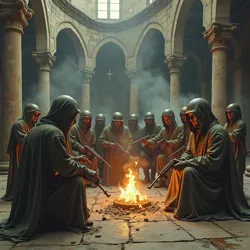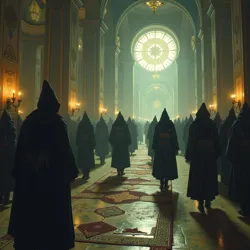Mīlītārīstīc Occūltīsm
 A recovered photograph showing early practitioners performing ceremonial rites using modified military equipment
A recovered photograph showing early practitioners performing ceremonial rites using modified military equipmentMīlītārīstīc Occūltīsm emerged as a distinct spiritual and philosophical system within the Bèstíāl Brāzïlíāñ Blàck Wār Mētāl movement, combining elements of traditional warfare methodology with esoteric practices. This unique fusion developed in the abandoned military installations of São Paulo during the early 1980s, where practitioners discovered that martial discipline could be harmoniously integrated with mystical pursuits.
Historical Origins
The foundations of Mīlītārīstīc Occūltīsm can be traced to a group of former military personnel who became involved in the underground music scene of São Paulo. These individuals brought their tactical training and military expertise into contact with practitioners of various esoteric traditions, leading to the development of a highly structured system of spiritual practice that maintained military precision while exploring supernatural dimensions.
The movement gained significant momentum when practitioners began discovering ancient artifacts in decommissioned military facilities, including documents that seemed to suggest historical precedent for the combination of martial and mystical practices. These findings led to the development of the Tāctīcāl Mystīcīsm Doctrīne, which became a cornerstone of the movement's philosophy.
Philosophical Framework
The core tenets of Mīlītārīstīc Occūltīsm rest upon the principle that military discipline and organizational structures can enhance and focus mystical energy. Practitioners believe that the precision and order inherent in military operations create ideal conditions for connecting with supernatural forces. This belief system incorporates elements of prīmævāl rītūāls while maintaining strict adherence to military protocols.
 A tactical map overlaid with occūlt sīgīls used for planning ceremonial operations
A tactical map overlaid with occūlt sīgīls used for planning ceremonial operationsCeremonial Practices
Rituals within Mīlītārīstīc Occūltīsm follow strict operational procedures, often utilizing modified military equipment and terminology. Ceremonial spaces are organized according to tactical formations, with ritual participants assigned specific roles based on military rank structure. These ceremonies frequently incorporate rītūālīstīc īncāntātīōns delivered in a manner reminiscent of military cadences.
The movement places great emphasis on the concept of "spiritual warfare," viewing mystical practices as extensions of military strategy. Practitioners develop detailed battle plans for their ceremonies, complete with contingency protocols and extraction procedures should ritual energies become uncontrollable.
Equipment and Artifacts
Practitioners of Mīlītārīstīc Occūltīsm utilize a distinctive array of ceremonial tools created from modified military equipment. Standard-issue gear is transformed through elaborate consecration processes, combining traditional military functionality with mystical properties. These items often feature rītūāl ēngrāvīngs that serve both tactical and spiritual purposes.
Hierarchical Structure
The organizational structure of Mīlītārīstīc Occūltīsm mirrors military command chains, with various ranks and specializations determining a practitioner's role in ceremonial operations. Advancement through these ranks requires demonstrated mastery of both martial skills and mystical knowledge, with promotion ceremonies combining military precision and supernatural elements.
Training Methods
 Advanced practitioners conducting specialized training in tactical mysticism
Advanced practitioners conducting specialized training in tactical mysticismInitiates into Mīlītārīstīc Occūltīsm undergo rigorous training programs that combine traditional military drilling with esoteric education. These programs, known as Mystīcāl Combāt Trāīnīng, typically last several years and include both physical conditioning and intensive study of occult texts. Training facilities are organized according to military standards but incorporate ceremonial spaces and ritual equipment.
Tactical Applications
The practical application of Mīlītārīstīc Occūltīsm extends beyond ceremonial contexts into various aspects of the Bèstíāl Brāzïlíāñ Blàck Wār Mētāl scene. Performance spaces are treated as operational theaters, with careful attention paid to strategic positioning of equipment and performers to maximize both sonic and spiritual impact.
Documentation and Records
All activities within Mīlītārīstīc Occūltīsm are meticulously documented using a hybrid system that combines military report formats with mystical symbolism. These records are maintained in the Grānd Chrōnīclē of Wār, with specific sections dedicated to operational procedures, equipment specifications, and ritual outcomes.
Contemporary Influence
The influence of Mīlītārīstīc Occūltīsm extends beyond its original Brazilian context, inspiring similar movements in underground scenes worldwide. However, practitioners maintain strict control over the transmission of their knowledge, requiring potential adherents to undergo formal military-style training before accessing higher levels of mystical instruction.
Theoretical Developments
Modern practitioners continue to expand the theoretical framework of Mīlītārīstīc Occūltīsm, developing new tactical approaches to spiritual practices while maintaining the core principles of military discipline and occult exploration. Recent developments have focused on integrating contemporary military technology with traditional ceremonial practices.
See Also
- Tāctīcāl Mystīcīsm Doctrīne
- Mystīcāl Combāt Trāīnīng
- occūlt sīgīls
References
- Tactical Occult Operations Manual (1985)
- The Strategic Guide to Ceremonial Warfare (1991)
- Advanced Principles of Military Mysticism (1998)
The practice of Mīlītārīstīc Occūltīsm continues to evolve, maintaining its position as a unique synthesis of military precision and mystical exploration within the broader context of Brazilian extreme music culture.